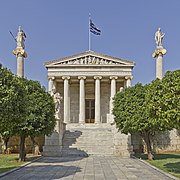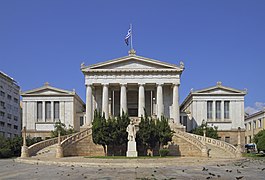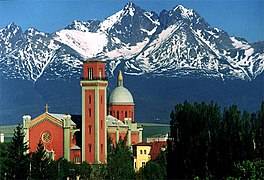Theophil Hansen: Difference between revisions
RodRabelo7 (talk | contribs) |
use Template:ÖBL2 for Österreichisches Biographisches Lexikon 1815–1950; some MOS:DASH; "Further reading" alphabetical. |
||
| Line 1: | Line 1: | ||
{{Short description|Danish-Austrian architect (1813–1891)}} |
{{Short description|Danish-Austrian architect (1813–1891)}} |
||
{{use dmy dates|date=September 2024}} |
|||
[[File:TheophilHansen.jpg|thumb|right|200px|Baron Theophil von Hansen]] |
|||
[[File: |
[[File:TheophilHansen.jpg|thumb|upright|Baron Theophil von Hansen]] |
||
[[File:CCA01 sm53 Theophilos Hansen.jpg|thumb|upright|Hansen's grave at the [[Vienna Central Cemetery]]]] |
|||
'''Baron Theophil Edvard von Hansen''' ({{IPA|de|ˈteːofiːl fɔn ˈhanzn̩|lang}}; original |
'''Baron Theophil Edvard von Hansen''' ({{IPA|de|ˈteːofiːl fɔn ˈhanzn̩|lang}}; original Danish name: '''Theophilus Hansen''', {{IPA|da|tsʰe̝oˈfiːlus ˈhænˀsn̩|pron}}; 13 July 1813 – 17 February 1891) was a Danish architect who later became an Austrian citizen. He became particularly well known for his buildings and structures in Athens and Vienna, and is considered an outstanding representative of [[Neoclassicism]] and [[Historicism (art)|Historicism]].<ref>{{cite web|url=https://runeberg.org/dbl/7/0048.html|title= Theophilus Edvard Hansen, 1813–91, Arkitekt|publisher=Dansk biografisk Lexikon|access-date=1 May 2019}}</ref> |
||
| ⚫ | |||
==Biography== |
==Biography== |
||
Hansen was born in [[Copenhagen]]. After training with Prussian architect [[Karl Friedrich Schinkel]] and some years studying in Vienna, he moved to [[Athens]] in 1837, where he studied architecture and design, with a concentration and interest in [[Byzantine architecture]]. During his stay in Athens, Hansen designed his first building, the [[National Observatory of Athens]] and two of the three contiguous buildings forming the so-called "Athenian Trilogy": the [[Academy of Athens (modern)|Academy of Athens]] and the National Library of Greece, the third building of the trilogy being the [[National and Capodistrian University of Athens]], which was designed by his brother [[Christian Hansen (architect)|Hans Christian Hansen]] (1803–1883).<ref>{{cite web|url= |
Hansen was born in [[Copenhagen]]. After training with Prussian architect [[Karl Friedrich Schinkel]] and some years studying in Vienna, he moved to [[Athens]] in 1837, where he studied architecture and design, with a concentration and interest in [[Byzantine architecture]]. During his stay in Athens, Hansen designed his first building, the [[National Observatory of Athens]] and two of the three contiguous buildings forming the so-called "Athenian Trilogy": the [[Academy of Athens (modern)|Academy of Athens]] and the National Library of Greece, the third building of the trilogy being the [[National and Capodistrian University of Athens]], which was designed by his brother [[Christian Hansen (architect)|Hans Christian Hansen]] (1803–1883).<ref>{{cite web|url= https://www.architectural-review.com/essays/reputations-pen-portraits-/karl-friedrich-schinkel-1781-1841/10025236.article |title= Karl Friedrich Schinkel (1781–1841)|date= 27 November 2017|publisher=architectural-review.com |access-date=1 May 2019}}</ref> |
||
<ref>{{cite web|url= http://denstoredanske.dk/Kunst_og_kultur/Arkitektur/Norden/Christian_Hansen|title= |
<ref>{{cite web|url= http://denstoredanske.dk/Kunst_og_kultur/Arkitektur/Norden/Christian_Hansen|title=Christian Hansen|publisher= Den Store Danske, Gyldendal|author= Ida Haugsted |access-date=1 May 2019}}</ref><ref>{{cite web|url=http://www.greece-is.com/athenian-trilogy-perfection-form/ |title =Athenian Trilogy|website=greece-is.com |
||
| |
|date =17 December 2015|access-date=1 November 2019}}</ref> |
||
<ref>{{cite web|url= http://www.greece-is.com/athenian-trilogy-perfection-form/ |title =Athenian Trilogy|website=greece-is.com |
|||
| ⚫ | |||
The Greek-Austrian entrepreneur [[Georgios Sinas]] ( |
The Greek-Austrian entrepreneur [[Georgios Sinas]] (1783–1856), who donated the observatory, called Hansen to Vienna in 1846, where Hansen took up an apprenticeship with noted Austrian architect [[Ludwig Förster]] (1797–1863). In his early works, such as the museum in the [[Vienna Arsenal]], Hansen was still rather aligned to a more romantic style. In later years, he became the most outstanding representative of Renaissance-inspired historicism ([[Neo-Renaissance]]), which also came to be known as Viennese-style. This style extended into the smallest details of the interior design and partially accepted the courses of a synthesis of the arts.<ref>{{cite web|url=https://www.deutsche-digitale-bibliothek.de/person/gnd/119509369|title=Ludwig von Förster |publisher=[[Deutsche Digitale Bibliothek]]|access-date=1 May 2019}}</ref> |
||
In his early works, such as the museum at [[Arsenal (Vienna)|The Arsenal in Vienna]], Hansen was still rather aligned to a more romantic style. In later years, he became the most outstanding representative of Renaissance-inspired historicism ([[Neo-Renaissance]]), which also came to be known as Viennese-style. This style extended into the smallest details of the interior design and partially accepted the courses of a synthesis of the arts.<ref>{{cite web|url= https://www.deutsche-digitale-bibliothek.de/person/gnd/119509369|title= Ludwig von Förster |publisher= Deutsche Digitale Bibliothek |access-date=May 1, 2019}}</ref> |
|||
Along with Förster and many others, Hansen was one of the most important and influential architects of the Viennese [[Ringstraße]]. His most famous work is the [[Austrian Parliament Building|Austrian Parliament building]], which was created in the style of an ancient, neo-classic temple, and serves to refer to the Greek beginnings of [[democracy]]. |
Along with Förster and many others, Hansen was one of the most important and influential architects of the Viennese [[Ringstraße]]. His most famous work is the [[Austrian Parliament Building|Austrian Parliament building]], which was created in the style of an ancient, neo-classic temple, and serves to refer to the Greek beginnings of [[democracy]]. Hansen was originally a staunch critic of the Classical style that was taught to him at the Copenhagen Academy. Over the years, however, he came to incorporate Classical elements into his forms. ''Bauleiter'' on this project was Swiss-Austrian architect [[Hans Auer]] (1847–1906) who would go on to win the competition for the Swiss [[Federal Palace of Switzerland|Bundeshaus]].<ref>{{cite web|url= http://www.hls-dhs-dss.ch/textes/d/D19818.php|title= Hans Auer|publisher= Bibliographie der Schweizergeschichte |
||
| ⚫ | |||
<ref>{{cite web|url= http://www.hls-dhs-dss.ch/textes/d/D19818.php|title= Hans Auer|publisher= Bibliographie der Schweizergeschichte |
|||
|access-date=May 1, 2019}}</ref> |
|||
Hansen's famed [[Musikverein]] in Vienna is one of the most notable concert halls in the world; a concert hall whose design and acoustics are often admired and copied in present-day music houses.<ref>{{cite web|url= |
Hansen's famed [[Musikverein]] in Vienna is one of the most notable concert halls in the world; a concert hall whose design and acoustics are often admired and copied in present-day music houses.<ref>{{cite web|url= http://www.planet-vienna.com/spots/Musikverein/musikverein.htm|title= Musikverein|publisher=Planet-Vienna|access-date=1 May 2019}}</ref> |
||
[[File:Athens academy.jpg|thumbnail|300px|The modern [[Academy of Athens (modern)#Main building|Academy of Athens]], next to the [[University of Athens]] and the [[National Library of Greece|National Library]] (not shown) forming "the Athenian Trilogy". The academy and the university buildings were designed by |
[[File:Athens academy.jpg|thumbnail|300px|The modern [[Academy of Athens (modern)#Main building|Academy of Athens]], next to the [[University of Athens]] and the [[National Library of Greece|National Library]] (not shown) forming "the Athenian Trilogy". The academy and the university buildings were designed by Theophil Hansen (1885) in [[Ionic order|Greek Ionic]], academically correct even to the polychrome sculpture. The statues and columns were worked by [[Leonidas Drosis]].]] |
||
Hansen worked together with Austrian sculptor Vincenz Pilz ( |
Hansen worked together with Austrian sculptor Vincenz Pilz (1816–1896) and artist [[Carl Rahl]] (1812–1865), as well as with architect [[Otto Wagner]] (1841–1918).<ref>{{cite web|url= https://de.wikisource.org/wiki/BLK%C3%96:Pilz,_Vincenz|title= Vincenz Pilz (1816–1896)|publisher= Biographisches Lexikon des Kaiserthums Oesterreich |access-date=1 May 2019}}</ref><ref>{{cite book|chapter-url= https://de.wikisource.org/wiki/ADB:Rahl,_Carl|chapter= Rahl, Karl|title=[[Allgemeine Deutsche Biographie]]|year= 1888|page=167|access-date=1 May 2019}}</ref><ref>{{cite web|url= http://www.ottowagner.com/otto-wagner-en-US/https://www.deutsche-digitale-bibliothek.de/person/gnd/119509369|title=Otto Wagner, 1841–1918 |publisher=ottowagner.com |access-date=1 May 2019}}</ref> |
||
<ref>{{cite book|chapter-url= https://de.wikisource.org/wiki/ADB:Rahl,_Carl |title= Carl Rahl (1812-1865)|chapter= Rahl, Karl|series= Allgemeine Deutsche Biographie|year= 1888|page= 167|publisher= Allgemeine Deutsche Biographie |access-date=May 1, 2019}}</ref><ref>{{cite web|url= http://www.ottowagner.com/otto-wagner-en-US/https://www.deutsche-digitale-bibliothek.de/person/gnd/119509369|title=Otto Wagner, 1841-1918 |publisher=ottowagner.com |access-date=May 1, 2019}}</ref> |
|||
In 1884 Emperor [[Franz Joseph I of Austria|Franz Joseph]] honoured Hansen with a [[baron]]y in the Austrian nobility and he was since styled "[[Freiherr]] von Hansen".<ref>{{cite web|url= https://runeberg.org/nfca/0497.html |title =Pilz, Vincenz|website= Nordisk familjebok |
In 1884 Emperor [[Franz Joseph I of Austria|Franz Joseph]] honoured Hansen with a [[baron]]y in the Austrian nobility and he was since styled "[[Freiherr]] von Hansen".<ref>{{cite web|url= https://runeberg.org/nfca/0497.html |title =Pilz, Vincenz|website= Nordisk familjebok |
||
| ⚫ | |||
|access-date=November 1, 2019}}</ref> |
|||
| ⚫ | |||
| ⚫ | |||
|website=gedaechtnisdeslandes.at |access-date=November 1, 2019}}</ref> |
|||
He died in 1891 in Vienna. |
He died in 1891 in Vienna. |
||
| Line 36: | Line 30: | ||
* [[National Observatory of Athens]], 1842 |
* [[National Observatory of Athens]], 1842 |
||
* House of military invalids, [[Lviv]], |
* House of military invalids, [[Lviv]], 1851–1863 |
||
* [[Academy of Athens (modern)#Main building|Academy of Athens]], Athens, starting from 1856 |
* [[Academy of Athens (modern)#Main building|Academy of Athens]], Athens, starting from 1856 |
||
* [[Heeresgeschichtliches Museum|Museum of Military History]] in the |
* [[Heeresgeschichtliches Museum|Museum of Military History]] in the [[Vienna Arsenal]], 1856 |
||
* Old Municipal Hospital in [[Patras]], Greece, 1857 |
* Old Municipal Hospital in [[Patras]], Greece, 1857 |
||
* Cemetery chapel Christuskirche at the [[Matzleinsdorf Protestant Cemetery]], Vienna, 1858 |
* Cemetery chapel Christuskirche at the [[Matzleinsdorf Protestant Cemetery]], Vienna, 1858 |
||
* [[Holy Trinity Greek Orthodox Church, Vienna]], 1858–1861 |
* [[Holy Trinity Greek Orthodox Church, Vienna]], 1858–1861 |
||
* [[Palais Todesco]], Ringstrasse, Vienna, |
* [[Palais Todesco]], Ringstrasse, Vienna, 1861–1864 |
||
* [[Deutschmeister-Palais|Palace of Archduke Wilhelm]], Vienna, 1864–1868 |
* [[Deutschmeister-Palais|Palace of Archduke Wilhelm]], Vienna, 1864–1868 |
||
* [[Musikverein]], Vienna, 1867–1870 |
* [[Musikverein]], Vienna, 1867–1870 |
||
* [[Academy of Fine Arts Vienna]], 1871–1876 |
* [[Academy of Fine Arts Vienna]], 1871–1876 |
||
* |
* Philharmonic Concert Hall, [[Brno]], 1871–1873 |
||
* [[Vienna Stock Exchange]], 1874–1877 |
* [[Vienna Stock Exchange]], 1874–1877 |
||
* [[Austrian Parliament Building]], Vienna, 1874–1883 |
* [[Austrian Parliament Building]], Vienna, 1874–1883 |
||
* [[Zappeion]], Athens, |
* [[Zappeion]], Athens, 1874–1888 |
||
* New Lutheran church, [[Kežmarok]], |
* New Lutheran church, [[Kežmarok]], 1879–1892 |
||
* Castle |
* Castle Nadelburg, [[Lichtenwörth]], Lower Austria 1880–1882 |
||
* [[National Library of Greece]], Athens, starting from 1888 |
* [[National Library of Greece]], Athens, starting from 1888 |
||
| Line 57: | Line 51: | ||
<gallery mode="packed" heights="120px"> |
<gallery mode="packed" heights="120px"> |
||
07Athen Observatorium1.jpg| ''Athens Observatorium'' |
07Athen Observatorium1.jpg| ''Athens Observatorium'' |
||
Attica 06-13 Athens 28 Academy of Athens.jpg|''Academy of Athens'' part of the 'Athenian Trilogy' in |
Attica 06-13 Athens 28 Academy of Athens.jpg|''Academy of Athens'' part of the 'Athenian Trilogy' in Athens |
||
Wien - Haus des Wiener Musikvereins (1).JPG|''Musikverein'' building in Vienna |
Wien - Haus des Wiener Musikvereins (1).JPG|''Musikverein'' building in Vienna |
||
Musikverein Goldener Saal.jpg|''Goldener Saal'' in the ''Musikvereinsgebäude'' in Vienna |
Musikverein Goldener Saal.jpg|''Goldener Saal'' in the ''Musikvereinsgebäude'' in Vienna |
||
| Line 71: | Line 65: | ||
{{reflist}} |
{{reflist}} |
||
== |
== Further reading == |
||
| ⚫ | |||
| ⚫ | |||
* {{ÖBL2|Theophil|Hansen|1813|1891|title=Hansen, Theophil (Theophilos) Freiherr von (1813–1891), Architekt|volume=2|orig-year=1958|pages=181–182|date=30 November 2015|author=R[ichard] Kurdiovsky|ref=none}} |
|||
| ⚫ | |||
* Manfred Leithe-Jasper: |
* Manfred Leithe-Jasper: "[http://www.deutsche-biographie.de/pnd118545760.html Hansen, Theophilos Edvard Freiherr von]". In: ''[[Neue Deutsche Biographie]]'' (NDB). Vol. 7, Duncker & Humblot, Berlin 1966, {{ISBN|3-428-00188-5}}, pp. 634 f. |
||
* Julius Leisching: |
* Julius Leisching: "[[s:de:ADB:Hansen, Theophilos Edvard Freiherr von|Hansen, Theophilos Edvard Freiherr von]]". In: ''[[Allgemeine Deutsche Biographie]]'' (ADB). Vol. 49, Duncker & Humblot, Leipzig 1904, pp. 762–766. |
||
| ⚫ | |||
* ''[http://www.biographien.ac.at/oebl_2/181.pdf Hansen Theophil Edvard Frh. von]''. In: Österreichisches Biographisches Lexikon 1815–1950 (ÖBL). Band 2, Verlag der Österreichischen Akademie der Wissenschaften, Wien 1959, S. 181 f. |
|||
| ⚫ | |||
| ⚫ | |||
| ⚫ | |||
| ⚫ | |||
| ⚫ | |||
| ⚫ | |||
| ⚫ | |||
| ⚫ | |||
== Notes == |
|||
{{German title Freiherr}} |
|||
==External links== |
==External links== |
||
* {{Commons category-inline}} |
* {{Commons category-inline}} |
||
{{Portal bar|Biography|Architecture}} |
|||
{{Authority control |
{{Authority control|state=collapsed}} |
||
{{DEFAULTSORT:Hansen, Theophil Von}} |
{{DEFAULTSORT:Hansen, Theophil Von}} |
||
Latest revision as of 12:00, 7 September 2024


Baron Theophil Edvard von Hansen (German: [ˈteːofiːl fɔn ˈhanzn̩]; original Danish name: Theophilus Hansen, pronounced [tsʰe̝oˈfiːlus ˈhænˀsn̩]; 13 July 1813 – 17 February 1891) was a Danish architect who later became an Austrian citizen. He became particularly well known for his buildings and structures in Athens and Vienna, and is considered an outstanding representative of Neoclassicism and Historicism.[1]
Biography
[edit]Hansen was born in Copenhagen. After training with Prussian architect Karl Friedrich Schinkel and some years studying in Vienna, he moved to Athens in 1837, where he studied architecture and design, with a concentration and interest in Byzantine architecture. During his stay in Athens, Hansen designed his first building, the National Observatory of Athens and two of the three contiguous buildings forming the so-called "Athenian Trilogy": the Academy of Athens and the National Library of Greece, the third building of the trilogy being the National and Capodistrian University of Athens, which was designed by his brother Hans Christian Hansen (1803–1883).[2] [3][4]
The Greek-Austrian entrepreneur Georgios Sinas (1783–1856), who donated the observatory, called Hansen to Vienna in 1846, where Hansen took up an apprenticeship with noted Austrian architect Ludwig Förster (1797–1863). In his early works, such as the museum in the Vienna Arsenal, Hansen was still rather aligned to a more romantic style. In later years, he became the most outstanding representative of Renaissance-inspired historicism (Neo-Renaissance), which also came to be known as Viennese-style. This style extended into the smallest details of the interior design and partially accepted the courses of a synthesis of the arts.[5]
Along with Förster and many others, Hansen was one of the most important and influential architects of the Viennese Ringstraße. His most famous work is the Austrian Parliament building, which was created in the style of an ancient, neo-classic temple, and serves to refer to the Greek beginnings of democracy. Hansen was originally a staunch critic of the Classical style that was taught to him at the Copenhagen Academy. Over the years, however, he came to incorporate Classical elements into his forms. Bauleiter on this project was Swiss-Austrian architect Hans Auer (1847–1906) who would go on to win the competition for the Swiss Bundeshaus.[6]
Hansen's famed Musikverein in Vienna is one of the most notable concert halls in the world; a concert hall whose design and acoustics are often admired and copied in present-day music houses.[7]

Hansen worked together with Austrian sculptor Vincenz Pilz (1816–1896) and artist Carl Rahl (1812–1865), as well as with architect Otto Wagner (1841–1918).[8][9][10]
In 1884 Emperor Franz Joseph honoured Hansen with a barony in the Austrian nobility and he was since styled "Freiherr von Hansen".[11][12]
He died in 1891 in Vienna.
Work
[edit]- National Observatory of Athens, 1842
- House of military invalids, Lviv, 1851–1863
- Academy of Athens, Athens, starting from 1856
- Museum of Military History in the Vienna Arsenal, 1856
- Old Municipal Hospital in Patras, Greece, 1857
- Cemetery chapel Christuskirche at the Matzleinsdorf Protestant Cemetery, Vienna, 1858
- Holy Trinity Greek Orthodox Church, Vienna, 1858–1861
- Palais Todesco, Ringstrasse, Vienna, 1861–1864
- Palace of Archduke Wilhelm, Vienna, 1864–1868
- Musikverein, Vienna, 1867–1870
- Academy of Fine Arts Vienna, 1871–1876
- Philharmonic Concert Hall, Brno, 1871–1873
- Vienna Stock Exchange, 1874–1877
- Austrian Parliament Building, Vienna, 1874–1883
- Zappeion, Athens, 1874–1888
- New Lutheran church, Kežmarok, 1879–1892
- Castle Nadelburg, Lichtenwörth, Lower Austria 1880–1882
- National Library of Greece, Athens, starting from 1888
Gallery
[edit]-
Athens Observatorium
-
Academy of Athens part of the 'Athenian Trilogy' in Athens
-
Musikverein building in Vienna
-
Goldener Saal in the Musikvereinsgebäude in Vienna
-
The Zappeion Megaron in Athens
-
Castle Nadelburg in Lichtenwörth, Lower Austria
-
Reichsrat in Vienna, today the Austrian Parliament Building
-
Palais Hansen in Vienna
-
National Library of Greece
-
New Lutheran church in Kežmarok
References
[edit]- ^ "Theophilus Edvard Hansen, 1813–91, Arkitekt". Dansk biografisk Lexikon. Retrieved 1 May 2019.
- ^ "Karl Friedrich Schinkel (1781–1841)". architectural-review.com. 27 November 2017. Retrieved 1 May 2019.
- ^ Ida Haugsted. "Christian Hansen". Den Store Danske, Gyldendal. Retrieved 1 May 2019.
- ^ "Athenian Trilogy". greece-is.com. 17 December 2015. Retrieved 1 November 2019.
- ^ "Ludwig von Förster". Deutsche Digitale Bibliothek. Retrieved 1 May 2019.
- ^ "Hans Auer". Bibliographie der Schweizergeschichte. Retrieved 1 May 2019.
- ^ "Musikverein". Planet-Vienna. Retrieved 1 May 2019.
- ^ "Vincenz Pilz (1816–1896)". Biographisches Lexikon des Kaiserthums Oesterreich. Retrieved 1 May 2019.
- ^ "Rahl, Karl". Allgemeine Deutsche Biographie. 1888. p. 167. Retrieved 1 May 2019.
- ^ "Otto Wagner, 1841–1918". ottowagner.com. Retrieved 1 May 2019.
- ^ "Pilz, Vincenz". Nordisk familjebok. Retrieved 1 November 2019.
- ^ "Karl Rahl". gedaechtnisdeslandes.at. Retrieved 1 November 2019.
Further reading
[edit]- Robert Bachtrögl: Die Nadelburg – Geschichte ab 1747. 2010 (Theophil Hansen starting at p. 77)
- R[ichard] Kurdiovsky (30 November 2015) [1958]. "Hansen, Theophil (Theophilos) Freiherr von (1813–1891), Architekt". Österreichisches Biographisches Lexikon ab 1815 (online) (in German). Vol. 2. Austrian Academy of Sciences. pp. 181–182.
- Manfred Leithe-Jasper: "Hansen, Theophilos Edvard Freiherr von". In: Neue Deutsche Biographie (NDB). Vol. 7, Duncker & Humblot, Berlin 1966, ISBN 3-428-00188-5, pp. 634 f.
- Julius Leisching: "Hansen, Theophilos Edvard Freiherr von". In: Allgemeine Deutsche Biographie (ADB). Vol. 49, Duncker & Humblot, Leipzig 1904, pp. 762–766.
- George Niemann (ed.), Ferdinand von Feldegg: Theophilus Hansen und seine Werke. A. Schroll & Co., Wien 1893.
- Andreas P. Pittler, Hermann Schnell: Der Baumeister des Parliaments – Theophil Hansen (1813–1891). Edition Winkler-Hermaden, Vienna 2013, ISBN 978-3950361100
- Adolf Stiller (ed).: Theophil Hansen – Klassische Eleganz im Alltag. Müry Salzmann, Salzburg / Vienna 2013, ISBN 978-3-990140-76-5.
- Alice Strobl: "Das k. k. Waffenmuseum im Arsenal. Der Bau und seine künstlerische Ausschmückung", in: Schriften des Heeresgeschichtlichen Museums in Wien, published by the museum. Graz / Cologne, 1961
- Renate Wagner-Rieger and Mara Reissberger (1980) Theophil von Hansen. (Series: Die Wiener Ringstraße VIII; vol. 4) Wiesbaden: Steiner ISBN 3-515-02676-2
External links
[edit] Media related to Theophil Hansen at Wikimedia Commons
Media related to Theophil Hansen at Wikimedia Commons
- 1813 births
- 1891 deaths
- Austrian barons
- Austrian people of Danish descent
- Danish expatriates in Austria
- Danish neoclassical architects
- Burials at the Vienna Central Cemetery
- Architects from Copenhagen
- Recipients of the Royal Gold Medal
- People associated with the Academy of Fine Arts Vienna
- Theophil Hansen buildings
- Architecture of Athens
- 19th-century Danish architects










